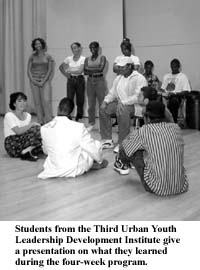

The freshman class was selected from 14,713 freshman applications received. In 1996 the University welcomed a freshman class of 2,007 students out of 13,667 applicants. The students come from New York State (94 percent) and 18 other states around the country.
This year’s incoming freshman class is marked by the presence of an estimated 170 new Presidential Scholars — the highest number yet. The Scholars program, which started five years ago with 40 students, now has about 500. Students are invited into this program based on their high school average and outstanding performance on standardized tests. They receive priority registration status for lower division courses, the opportunity to live in honors housing, and other academic privileges.
Another unique feature of the incoming freshman class is that last year’s pilot program, Project Renaissance, has doubled in size to 400 students. Students in Project Renaissance said they enjoyed the small class sizes, the focus on technology, and the supportive academic environment of this living-learning community.
Students living at Dutch Quad will find a newly remodeled dining hall, a new weight room, renovated elevators and a remodeled Stuyvesant Tower, complete with 440 new mattresses, new bedroom furniture, and a sports theme snack bar and game room. New mattresses and bedroom furniture have also been installed at Colonial Heights. High-speed ResNet connections to the Internet and library resources are now available in all the residence halls.
Greta Petry
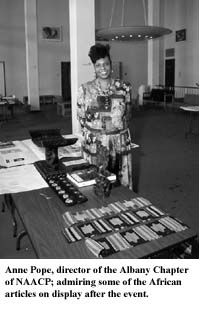 By Lisa James
By Lisa James
This summer, the University and the African American Research Foundation got together to sponsor the Third Urban Leadership Development Institute at Albany High School. The 40 middle school graduates who participated presented their exhibitions on what they learned during the course of the program on August 1 in the Recital Hall of the Performing Arts Center.
The Institute was designed to enable incoming freshmen to get involved in classroom and out-of-classroom activities. It addressed the problems associated with the transition from middle school to high school.
The theme this year was “Leadership and Democracy.” The students were organized into
three mini-democratic communities to investigate two topics during the four-week
program. The topics were: “The contributions of Africa and Africans to ordinary life
in the United States” and “The world of children who grow up in cities.” The
exhibitions will focus on these topics.

“We are hopeful that the middle school graduates who complete the summer Institute will have acquired not only an understanding of the educational importance of their cultural backgrounds but also a peer group of students who support them in their efforts to achieve their personal and academic goals,” said Donald Biggs, director of Urban Education at the University.
Fifteen of the University’s undergraduate and graduate students and 17 high school students served as mentors. In addition, the Empire State Theatre Institute worked with the students to help them present their theatre exhibitions.
The Institute is the result of the collaboration of a number of community offices, organizations and associations including Albany High School, Livingston Middle School, Hackett Middle School, the Office of the Superintendent of Schools, the Office of the Mayor, the Essential School Program at Albany High School, the Empire State Theatre Institute, Arbor Park Day Care, Arbor Hill Community Center, and the Kenwood Child Development Center.
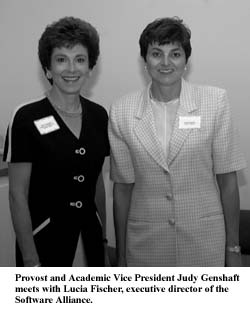 The University announced in August the beginning of talks with community business
leaders from the Capital Region Software Alliance.
The University announced in August the beginning of talks with community business
leaders from the Capital Region Software Alliance.
“We are excited about having the opportunity to work with the alliance in order to promote the local software industry and to attract more students to it,” said Provost and Vice President for Academic Affairs Judy Genshaft. “This is a winning combination. The benefits that will come from our successful collaboration with the alliance will enhance the local economy.”
There are about 125 software companies in the Capital Region, according to the represenatives from the alliance. While based locally, many of these hi-tech firms do business with clients around the world. For example, Len DeForge, human resource director for IFS of Troy, said IFS works on electronic fund transfer systems in 24 nations. Jim O’Keefe, president and CEO of ILINC of Troy, noted that among his firm’s 30 employees, 9 languages are spoken to meet the needs of the company’s international clientele.
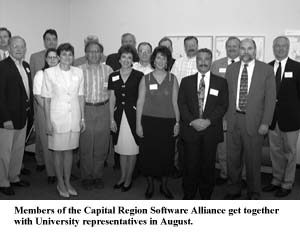 To date, discussion between the University and the alliance has centered on: the
availability of more than 100 computer programming and consulting jobs at area
software companies; a proposal to conduct continuing professional training at Albany
for company employees; tentative plans for an on-campus job fair for the firms in the
alliance; and student internships.
To date, discussion between the University and the alliance has centered on: the
availability of more than 100 computer programming and consulting jobs at area
software companies; a proposal to conduct continuing professional training at Albany
for company employees; tentative plans for an on-campus job fair for the firms in the
alliance; and student internships.
In addition, the alliance is interested in contacting University alumni to let them know about the career opportunities now available.
“The Capital Region’s healthy, growing computer software industry has been a well-kept secret,” said Lucia Fischer, executive director of the Software Alliance, which is supported by the Center for Economic Growth.
“This partnership will bring visibility to the successful businesses right in our back yard.”
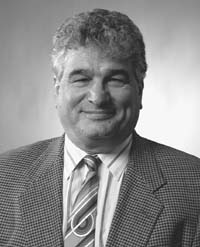 Abdo I. Baaklini, director of the center and professor of public administration in
the Rockefeller College School of Public Affairs and Policy, announced the visit of
the high-ranking delegation from Guinea-Bissau, which visited Albany as well as other
cities in the U.S. and Brazil between July 28 and Aug. 16.
Abdo I. Baaklini, director of the center and professor of public administration in
the Rockefeller College School of Public Affairs and Policy, announced the visit of
the high-ranking delegation from Guinea-Bissau, which visited Albany as well as other
cities in the U.S. and Brazil between July 28 and Aug. 16.
The members of the delegation head key parliamentary committees. Their visit enabled them to acquaint themselves with the procedures and policies of the State Legislature, the U.S. Congress, and other governmental institutions. For over two decades, CLD has been the primary institution in the U.S. offering academic and applied studies in the administration of legislative organizations, with projects carried out in such diverse areas as Central and South America, the Caribbean, Africa, Asia, Central Europe, and the Middle East.
“This visit was a component of Guinea-Bissau’s effort to develop politically and economically,” Professor Baaklini explained. “As part of that process, the National Assembly must acquire the institutional capacity to act as full partner in Guinea-Bissau’s developing democracy, and the delegation’s visit to the University and the Legislature assisted in that effort.”
Guinea-Bissau, located in West Africa, gained its independence from Portugal in 1973. In the late 1980s its government began mobilizing efforts to liberalize its economic and political institutions. In order to support that effort, CLD became a partner in the Trade and Investment Promotion Support (TIPS) Project, sponsored by the U.S. Agency for International Development. The Center’s role in the project is to assist in strengthening Guinea-Bissau’s legislative and judicial systems to facilitate and sustain their transition to democracy.
The deputies’ itinerary includes a meeting with Baaklini, Albany Assemblyman Jack McEneny, State Senator Larry Seabrook, other members of the University administration, and legislative staff members. In addition, the delegation traveled to Washington, DC, where they attended meetings at Congressman Michael McNulty’s office and received briefings on the legislative process, the role of legislative committees, constituent relations, and other issues regarding legislative management.
The delegation then traveled to Philadelphia to attend the annual meeting of the National Conference of State Legislatures, followed by a week in Brazil, where they met with representatives of the Federal Senate in Brasilia.
Members of the delegation included: Salvador Tchongo, second deputy vice president and president of the Committee on Institutionalization; Alexandre Bucancile, president of the Committee for Judicial, Constitutional, Human Rights and Public Administrational Affairs; Soares Sambu, president of the Committee on Agriculture, Fisheries, Natural Resources, Environment and Tourism; Carlitos Barai, president of the Committee on Foreign Affairs, International Cooperation and Emigration;. and Geraldo Martins, advisor, Trade and Investment Promotion Support Project.
“Building appropriate and effective institutions is an important part of keeping a country on the path to an open, democratic, multi-party system,” Professor Baaklini said. “Despite the differences between New York and Guinea-Bissau, many procedures, systems and technologies used in the State Legislature can be applied in Guinea-Bissau to help make their National Assembly more open and effective in the public policy process.”
 Lydia A. Finney, a chemistry major from Fulton who plays the cello in a string
quartet, and who won a national Goldwater Scholarship last spring, also became one of
20 students to receive the first-ever Chancellor’s Award for Student Excellence.
Lydia A. Finney, a chemistry major from Fulton who plays the cello in a string
quartet, and who won a national Goldwater Scholarship last spring, also became one of
20 students to receive the first-ever Chancellor’s Award for Student Excellence.
Chancellor John W. Ryan, in wishing to recognize students who have demonstrated outstanding academic achievement, created the honor and presented the awards at a reception at SUNY Plaza in on May 27.
The newly created annual award is aimed at honoring those SUNY students who have achieved significant recognition and acclaim during the past academic year.
Finney was one of nine college students in the SUNY system to be honored with the prestigious Barry M. Goldwater Scholarship and Excellence in Education Program, whose scholarship covers the cost of tuition, fees, books, and room and board up to a maximum of $7,500 per year for up to two years.
Finney said at the time that she chose Albany because she was invited to become a Presidential Scholar. A member of the Presidential Honor Society, Golden Key National Honor Society and the Newman Association, Finney plans to earn a Ph.D. in chemistry, and works on research with chemistry professor William E. Broderick, who calls Finney, now a junior, “the best student that I’ve come in contact with in my career.”
Albany is one of the select number of schools to have been listed among the nation’s top 25 best college values for all eight years that Money has conducted the survey. The University was ranked 15th a year ago.
A few days after the Money survey, Albany was again ranked by U.S. News & World Report magazine as on of the nation’s top 115 “national universities,” placing in an alphabetical listing in the “second tier” group (rank 51 to 115) among more than 230 listed campuses. The survey measured such categories as academic reputation, student selectivity, college entrance test scores, class size, graduation rate, faculty quality and financial resources.
In Money’s “Top Values Ranked by Choosiness” category, the University placed sixth in the highly selective listing. That ranking reflects how 30 of Money’s top buys compare as values when grouped with schools that are equally demanding about academic qualifications for admissions.
President Hitchcock said Albany’s consistently high national rankings attest to the quality of education that students receive, their success and the dedication and professional excellence of Albany’s faculty.
“This demonstrates that the University at Albany ranks among the elite institutions in the outstanding SUNY system of public higher education, and in the top one percent of all higher education institutions in the nation,” she said.